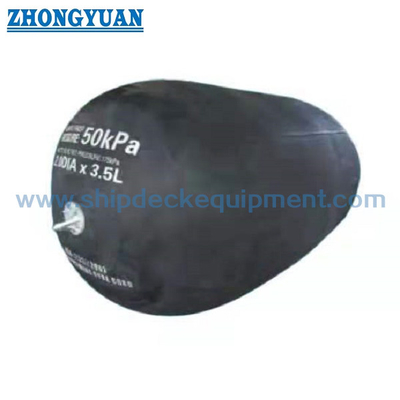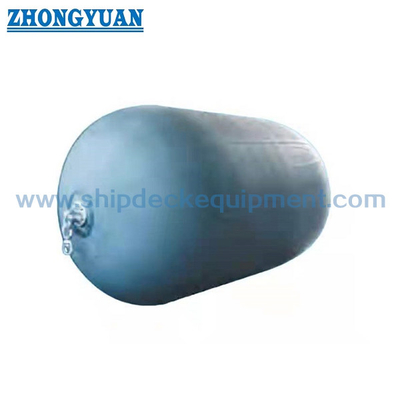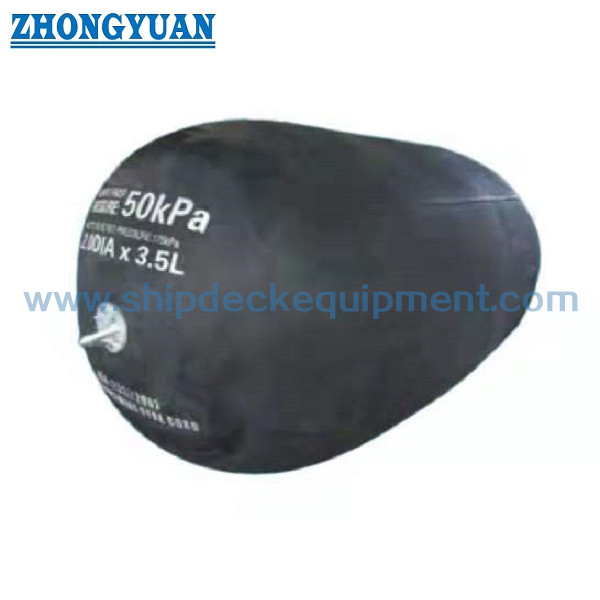ISO 17357 Sling Type Yokohama Floating Pneumatic Marine Rubber Fenders Marine Rubber Fender
Product Details:
| Place of Origin: | China |
| Brand Name: | Zhongyuan |
| Certification: | CCS, NK, BV, ABS, DNV-GL, LR, KR, IRS, RS, RINA, Makers Test Certificate, Etc. |
| Model Number: | Standard and Customized |
Payment & Shipping Terms:
| Minimum Order Quantity: | 1 |
|---|---|
| Price: | As per quotation |
| Packaging Details: | Pallet or Customized |
| Delivery Time: | As per offer |
| Payment Terms: | TT, L/C, Etc. |
| Supply Ability: | Satisfy clients needs |
|
Detail Information |
|||
| Technical Standard: | ISO 17357:2014, | Fender Size:: | Dia.1000 X L 3000m To Dia. 4500 X L 30000m (low Pressure), Dia.500 X L 1000m To Dia.4500 X L 12000m (high Pressure) |
|---|---|---|---|
| High Pressure Fender Type:: | Net-type; Net-type And One End With No Flange Opening And No Metal Parts; Sling-type; | Low Pressure Fender Type:: | Clamped End Type; Moulded End Type. |
| Safety:: | Safety Valve Is Equipped As Standard Or As Inquiry; | Initial Internal Pressure:: | 7 KPa For Low Pressure Fender, 50 KPa & 80 KPa For High Pressure Fender; |
| Test And Inspection:: | Material Test Of Rubber, Dimensional Inspection, Air-leakage Test, Hydrostatic-pressure Test | Certificate:: | CCS, NK, BV, ABS, DNV-GL, LR, KR, IRS, RS,Prototype Fender Test Certificate, Commercial Fender Inspection And Test Certificate |
| Installation:: | Welded On The Chain Locker | Fender Colour:: | If Not Specified, The Colour Shall Be Black, As Buyer’s Inquiry |
| Identification System:: | As ISO 17357 Standard And Buyer’s Inquiry; | ||
| Highlight: | iso 17357 pneumatic rubber fenders,iso 17357 marine rubber fender,yokohama marine rubber fender |
||
Product Description
ISO 17357 Sling Type Yokohama Floating Pneumatic Marine Rubber Fenders Marine Rubber Fender
Description:
ISO 17357 sling type Yokohama floating pneumatic marine rubber fenders can play an important role in a ships safe berthing operation. Essentially there are two main types of floating pneumatic rubber fender, defined as either high or low pressure fenders. Although manufactured using different techniques, both high and low pressure fenders work by the same principle. The resistance to berthing vessel momentum is provided by a reaction pressure due to compression of the air inside the fender when deformed by the vessels hull. The kinetic energy of the berthing vessel is absorbed during the work done to compress the air inside the fender. Fenders are sized according to the expected duty of the fender in terms of the energy absorption (EA) requirements which will be at the most basic level, a function of the vessel mass and velocity.
Sling type fenders are net type fenders without chains or tyre nets, but with a specially processed outer rubber double-layered cove r, which consist s of a single cover and an extra tyre cord layer, resulting in better resistance to operational damages .
Main Technical Specifications:
- Standard: ISO 17357:2014,
- Initial internal pressure: 7 kPa for low pressure fender, 50 kPa & 80 kPa for high pressure fender;
- High Pressure Fender Type: Net-type; Net-type and one end with no flange opening and no metal parts; Sling-type;
- Low Pressure Fender Type: Clamped end type; Moulded end type.
- Fender size: Dia.1000 x L 3000m to Dia. 4500 x L 30000m (low pressure), Dia.500 x L 1000m to Dia.4500 x L 12000m (high pressure)
- Safety: Safety valve is equipped as standard or as inquiry;
- Fender colour: If not specified, the colour shall be black, As buyer’s inquiry
- Identification system: As ISO 17357 standard and buyer’s inquiry;
- Test and inspection: Material test of rubber, Dimensional inspection, Air-leakage test, Hydrostatic-pressure test
- Certificate: Classification society, Prototype fender test certificate, Commercial fender inspection and test certificate
- Can be customized;
Main Technical Parameters:
| Pneumatic 50 fender size and performance requirements | ||||
| Nominal size diameter x length mm |
Initial Internal pressure kPa |
Guaranteed energy absorption (GEA) |
Reaction force at GEA deflection (R) |
Hull pressure (Internal pressure) at GEA deflection (P) |
| Minimum value at deflect10n 6 0 土 5 % kj |
Tolerance 土 10 % kN |
Reference value kPa |
||
| 500 X 1 000 | 50 | 6 | 64 | 132 |
| 600 X 1 000 | 50 | 8 | 74 | 126 |
| 700 X 1 500 | 50 | 17 | 137 | 135 |
| 1 000 X 1 500 | 50 | 32 | 182 | 122 |
| 1 000 X 2 000 | 50 | 45 | 257 | 132 |
| 1200 X 2 000 | 50 | 63 | 297 | 126 |
| 1 350 X 2 500 | 50 | 102 | 427 | 130 |
| 1 500 X 3 000 | so | 153 | 579 | 132 |
| 1 700 X 3 000 | 50 | 191 | 639 | 128 |
| 2 000 X 3 500 | 50 | 308 | 875 | 128 |
| 2 500 X 4 000 | 50 | 663 | 1381 | 137 |
| 2 500 X 5 500 | 50 | 943 | 2 019 | 148 |
| 3 300 X 4 500 | 50 | 1175 | 1884 | 130 |
| 3 300 X 6 500 | 50 | 1814 | 3 015 | 146 |
| 3 300 X 10 600 | 50 | 3 067 | 5 257 | 158 |
| 4 500 X 9 000 | 50 | 4 752 | 5 747 | 146 |
| 4 500 X 12 000 | 50 | 6 473 | 7 984 | 154 |
| Pneumatic 50 fender pressure requirements | ||||||
|
Nominal size
|
Internal pressure | Minimum endurable pressure | Safety-valve pressure setting |
Testing pressure at 0% deflect10n |
||
| at 0% deflection kPa |
at 60 % deflection kPa |
at 0% deflection kPa |
at 60 % deflection kPa |
kPa | kPa | |
| 500 X 1 000 | 50 | 132 | 300 | 462 | - | 200 |
| 600 X 1 000 | so | 126 | 300 | 441 | - | 200 |
| 700 X 1 500 | 50 | 135 | 300 | 473 | - | 200 |
| 1 000 X 1 500 | 50 | 122 | 300 | 427 | - | 200 |
| 1 000 X 2 000 | so | 132 | 300 | 462 | - | 200 |
| 1200 X 2 000 | 50 | 126 | 300 | 441 | - | 200 |
| 1 350 X 2 500 | so | 130 | 300 | 455 | - | 200 |
| 1500 X 3 000 | so | 132 | 300 | 462 | - | 200 |
| 1 700 X 3 000 | 50 | 128 | 300 | 448 | - | 200 |
| 2 000 X 3 500 | 50 | 128 | 300 | 448 | - | 200 |
| 2 500 X 4 000 | 50 | 137 | 350 | 480 | 175 | 250 |
| 2 500 X 5 500 | 50 | 148 | 350 | 518 | 175 | 250 |
| 3 300 X 4 500 | 50 | 130 | 350 | 455 | 175 | 250 |
| 3 300 X 6 500 | 50 | 146 | 350 | 511 | 175 | 250 |
| 3 300 X 10 600 | 50 | 158 | 350 | 553 | 175 | 250 |
| 4 500 X 9 000 | 50 | 146 | 350 | 511 | 175 | 250 |
| 4 500 X 12 000 | so | 154 | 350 | 539 | 175 | 250 |
![]()
Drawing of ISO 17357 Sling Type Yokohama Floating Pneumatic Marine Rubber Fenders Marine Rubber Fender
![]()
![]()
![]()
![]()





